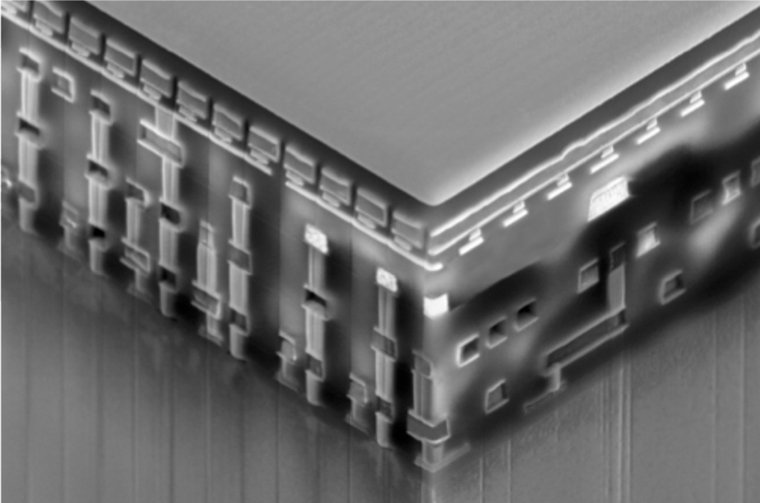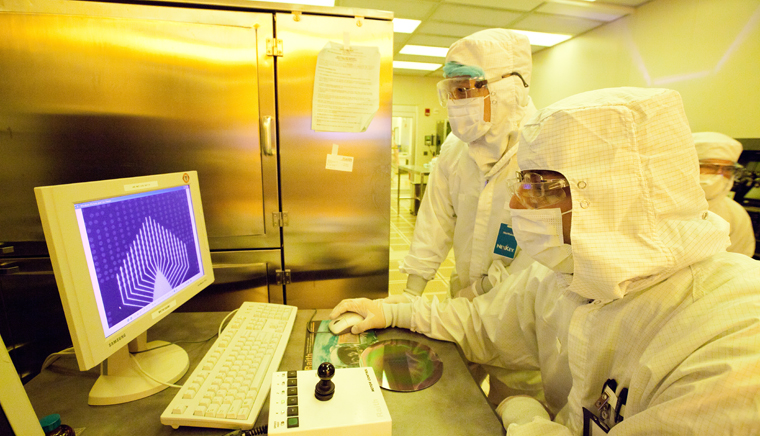Making Memory Smaller, Better, Faster, Stronger
Prof. Wei Lu and former student Dr. Sung Hyun Jo co-founded Crossbar, Inc. to tackle the physical limitations of conventional memory technology.

 Enlarge
Enlarge
In the battle for better computer memory, tech companies constantly push the limits of device speed, capacity, endurance, cost, and, most recently, size.
As tiny embedded computers spread to every item in the home and beyond – fast, reliable memory is needed on an unheard-of scale. To fuel this ongoing revolution, Prof. Wei Lu and former student Dr. Sung Hyun Jo co-founded the company Crossbar, Inc. to tackle the physical limitations of conventional memory technology. Dr. Jo is currently VP of Device & Advanced Technology at Crossbar.
With their take on Resistive Random Access Memory (RRAM), a growing alternative to industry-standard Flash, they’ve developed a solution that scales to the needs of shrinking technology without sacrificing speed and capacity. It promises to write much faster than Flash, and can fit at least 1TB of storage into the space of a postage stamp at very low cost.
Now with offices in both Silicon Valley and Shanghai and a commercial release pending within the year, Crossbar is poised to set a new bar for the memory market.
Smaller, Better, Faster, Stronger
Officially founded in 2010, the research behind Crossbar was initiated by Wei Lu in 2005 when he first arrived at the University of Michigan. Lu and Jo, his first student, published some of the earliest papers on the technology. The early research was heavily cited and resulted in a Samsung Human-Tech Thesis Prize for Jo’s dissertation. This research largely concerned an experimental circuit component called a memristor. A resistor with “memory,” these components are able to change or maintain their resistance based on the applied voltage. These became one of several central innovations defining Lu and Jo’s new memory technology.
By 2008 Lu was busy filing patents for the technology. This caught the eye of prominent Silicon Valley venture capital firm Kleiner Perkins Caufield & Byers (famed for its early investments in companies such as Google, Amazon, and Sun Microsystems). Before he had even gone so far as to organize a company around the technology, Lu was being approached by major investors.
“Kleiner felt that it could be a disruptive technology for the semiconductor industry,” says Lu.
In 2009, Crossbar was quietly formed while it began gathering funding and a leadership team. It was then that co-founders George Minassian and Hagop Nazarian, CEO and VP of Engineering, respectively, came aboard. By the following year, Crossbar’s founding was official; five years later, they had four rounds of funding and $85 million behind them.

 Enlarge
Enlarge
In 2013, Crossbar made waves in the tech industry when they introduced a prototype chip in a commercial foundry that demonstrated all the promised properties of RRAM. Since that time they’ve taken their first line of products from prototype to being market-ready. They are now in talks with household-name tech companies for deployment by the end of 2015.
You won’t be saving your videos and photos on these early products quite yet, though. Crossbar’s first target is a bit smaller than that.
Computer memory markets fall into two big categories: standalone applications (that 64GB iPhone in your pocket and your computer’s hard drive) and embedded applications (small computers in everything from your appliances to industrial equipment as part of the Internet of Things). Currently, these both largely rely on a technology called Flash storage.
Flash is old tech, and as computing gets smaller and smaller its limitations become more apparent. “Flash is not an ideal memory,” says Lu, “but it’s so mature that people can hide its deficiencies using a lot of clever tricks.”
However, using Crossbar’s RRAM, as devices get smaller, their performance actually improves, says Prof. Lu. “It also gets cheaper to make per bit, and our technology runs on very low power.”
Crossbar gets its name from the design trick that makes its RRAM so scalable. The secret is 3-D stacking – any number of metal layers can be added in a criss cross pattern, with a memory cell placed at each intersection. This simple three-layer structure allows for more and more memory to be added easily to a single unit, rather than needing bigger and bigger chips like traditional 2-D memory.

 Enlarge
Enlarge
The result is mutliple terabytes of storage on a single chip. The memory cells function the same no matter how many of them you stack, meaning at its smallest scale Crossbar’s RRAM functions at the same high efficiency. Traditional NAND Flash suffers big performance losses below the 25nm mark, while Crossbar’s RRAM maintains functionality even below 5nm.
Another advantage Crossbar has over other companies in the RRAM market is that its devices are compatible with fabrication processes that are already standard in the semiconductor industry. A new foundry can cost upwards of one to several billion dollars. Crossbar’s next-generation RRAM is already being produced at some of the largest foundries in the world.
An Expanding Business for Shrinking Memory
Prof. Lu and Dr. Jo already have eyes on markets beyond embedded memory. In addition to marketing its first product, Crossbar expects to have a working prototype of standalone memory by the end of this year. Their technology promises 20-100x improved performance over NAND Flash, up to 1TB of data storage on a single chip, and compatibility with existing semiconductor fabs, all while requiring 20X less power than conventional NAND.
With specs like this, Crossbar’s RRAM could put 250 hours of HD video on a cell phone in the not-too-distant future. It makes possible high-speed access to massive quantities of data in low-power storage centers; it enables smarter industrial and medical devices; it provides faster access to cloud-storage; it facilitates powerful wearable devices and embedded sensors that can communicate rapidly; and it adds one more vital piece to the Internet of Things puzzle.
To get their product into some of these niches quickly, Crossbar offers IP licensing for customers to integrate RRAM into their own micro-controllers and Systems-on-Chip. With their early embedded memory products, they’ll be targeting applications like IoT, wearable and tablet computers, and consumer, industrial, and automotive electronics.
With a market poised for better memory sooner rather than later, Crossbar is well-positioned for a large-scale takeover.
The Michigan Connection

 Enlarge
Enlarge
Wei Lu and Sung Hyun Jo made extensive use of Michigan’s resources to make their devices a reality, including the Lurie Nanofabrication Facility (Prof. Lu has repeatedly ranked as the facility’s biggest user).
“U-M’s facilities offer one of the world’s best research environments for students and researchers where they can explore several areas beyond conventional topics,” says Dr. Jo. “Half of my research was related to fabricating and optimizing nanoscale memory devices and materials, and therefore the high quality nanofabrication facilities of the LNF was a key factor in my success.”
Now VP of Device& Advanced Technology, Dr. Jo is experiencing the thrill of bringing academic research to market. He credits the “huge continued support and effort of several people such as circuit designers, system architects, manufacturing process engineers and quality & reliability engineers” for their current success, as well as the support from investors, including U-M.
The University of Michigan directly supported Crossbar as an early startup with an investment through the Michigan Investment in New Technology Startups fund (MINTS). Crossbar was the first company supported by this initiative.
“U of M showing a very firm interest early on was very helpful in discussions with other investors,” says Prof. Lu. “It also demonstrates the university’s commitment to advancing new disruptive technology.”

 Enlarge
Enlarge
Co-founded by Prof. Wei Lu and alumnus Dr. Sung Hyun Jo, Crossbar, Inc. is a semiconductor company focused on a new type of non-volatile memory called Resistive Random Access Memory (RRAM). Its first product is planned for release in late 2016, and will offer fast, reliable embedded memory for Internet of Things applications. Later projects will tackle memory for computers and mobile devices.
Offices in Santa Clara, CA and Shanghai, China
190 patents filed, 100 issued
$85M in venture capital backing
50 employees
Founded in 2010

 Enlarge
Enlarge
Prof. Wei Lu
Associate Professor
Chief Scientist and Co-Founder, Crossbar, Inc.
Professor We Lu’s research interests includes high-density memory based on two-terminal resistive devices (RRAM), memristors and memristive systems, neuromorphic circuits, aggressively scaled nanowire transistors, and other emerging electrical devices. In one major project that is based on the same memristor technology that gave rise to Crossbar, Inc., he is building neuromorphic circuits that could process images and video 1,000 times faster with 10,000 less power than today’s systems.
He has published over 100 journal and conference papers that have received over 12,000 citations. He is an editor at Nanoscale, and also serves on several IEEE committees.

 Enlarge
Enlarge
Dr. Sung Hyun Jo
PhD EE 2010
Vice President, Device & Advanced Technology, Co-Founder, Crossbar, Inc.
Dr. Sung Hyun Jo’s main research area includes emerging nonvolatile memory technology, with a special interest in RRAM. He conducted the first demonstration of a hybrid memristive synapse/CMOS neuron system. This system emulates the synaptic functions of a biological system. He also developed the prototype 3D stackable high density crossbar memory device – an integral part of Crossbar’s memory technology
Dr. Jo began work on Crossbar’s technology in 2005 as one of Prof. Lu’s first students. He has over 60 issued and pending U.S. patents and his publications have been cited over 3,000 times by peer researchers.
A New Way to Store Data
In the News
RRAM Leader Crossbar Enters China Memory Market – Crossbar press release, 2016
SMIC and RRAM Leader Crossbar Announce Strategic Partnership Agreement – Business Wire, 2016
Crossbar Closes Series D Funding of $35 Million – Business Wire, 2015
Machine Dreams – MIT Tech Review, 2015
Crossbar says it’s ‘one step’ from delivering miracle RRAM – The Register, 2014
In the Media
AI needs memory to get cozier with compute
EECS-ECE professor Wei Lu’s company, Crossbar, is featured in EE Times.
 MENU
MENU 
